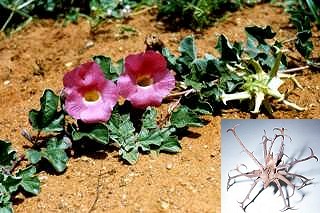
|
|
Devil's claw (Harpagophytum procumbens) flowers and fruit
|
Devil's claw - Harpagophytum procumbens
Devil's claw (Harpagophytum
procumbens) has nasty, spiny fruits but it is one of the chief medicinal plants southern Africa has given to the
world. Its uses are
multifarious and many tons of dried tubers are exported each year, mainly to
Europe. Most of this is harvested in the wild so there has been much concern about
over-harvesting. Efforts to get the plant into cultivation have not yet led to much
success.
Devil's claw is a prostrate, sprawling plant with a stout, perennial rootstock that has a group of secondary storage tubers arising from
it. Trailing annual stems bear opposite leaves. These are irregularly 3–5-lobed and greyish green because they are covered in tiny whitish mucilage
cells.
Harpagophytum procumbens, also called grapple
plant, wood spider and Devil's Claw. The name "devil's claw" is also used for several species of North American plants in the genus
Proboscidea.
The flowers are trumpet-shaped and range in colour from dark velvety red or purple to pink while the tube base and mouth are
yellowish; they can be all yellow, all purple or white. The very distinctive spiny
fruits, from which many of the common names are derived, are woody, oval and flattened capsules armed with 2 central spines and 2 lateral rows of 12 – 16 horny arms bearing hooked spines.The many seeds are roughly oblong and dark brown or
black. The plants flower mainly from about November to April (summer) and have fruits from about
January.
Devil's claw grows mostly in the savanna biome and is associated mainly with dry sandveld on deep Kalahari
sand. It usually occupies plains,
dune bases and interdunes. Soils are usually sandy but can be rocky. They are generally nutrient
poor, often with lime. The plants can probably withstand some frost as they are
geophytes, being dormant in winter. Distribution is often patchy.
The fruits are well adapted for dispersal by animals as the hooks get caught in feet and hair or skin and are carried
away. Eventually they wear down, or drop off and break open, releasing the seeds far from the
parent. Sometimes the animals die of starvation as the fruits catch on mouths and cannot be
dislodged. Wind may also help in dispersal and trampling will help bury the
seeds. The secondary tubers are dug up and eaten by porcupines and antelope such as duiker and
steenbok.
Devil's claw has long been known as a medicinal plant, with the San of the Kalahari having used it
first, many generations ago. A German, G.H. Mehnert, learnt about this plant from the San and Nama people in Namibia and let it be known in 1904. It was exported to Germany
first, and a small industry developed, based on material mainly from Namibia and
Botswana.
The plant's large tuberous roots are used medicinally to reduce pain and
fever, to stimulate digestion. European colonists brought Devil's Claw home where it was used to treat
arthritis.
World demand has risen a lot since 1962 and especially in this
century.
Devil's Claw is now claimed to be beneficial for treating
various diseases
Namibia has exported 2000 t. of dried roots in a year that may have involved up to 50 million
plants.
The harvesters, of whom there are thousands, are almost all from very poor, rural communities living in
near-desert conditions. They are mostly women, between 40 and 60 years old, who have little if any means of making a living and hence turn to harvesting devil's
claw. This is despite the poor rewards for long hours and long distances travelled on
foot.
Source:
http://www.plantzafrica.com/planthij/harpagpro.htm
